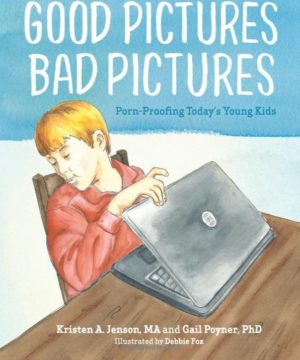I need to talk to my child about porn.
Now it’s time to talk. In today’s technologically advanced society, when our young children are old enough to cross the street safely by themselves or operate a device by themselves, we ought to be teaching them to also be safe online. This is where the conversation of online safety and pornography comes in using the resources below.
Book Suggestions for Parents to Read to/with Children
If your child sees you as a personal advocate for knowledge about these matters, he/she is much more likely to go to you rather than Google when curious.
Good Pictures, Bad Pictures (ages 7-9)
Explains the issue of pornography and the “C-A-N D-O” plan.
- Close your eyes, shut the laptop, X-out of the screen.
- Always tell a trusted adult.
- Name it. Call it what it is. (There’s power in saying things out loud.)
- Distract yourself. Think of happy things.
- Order your thinking brain to be the boss of your feeling brain.
Wonderfully Made Babies (ages 9+)
Theology of the Body inspired children’s book with medically correct language. This book gives a chaste, faith-based explanation of God’s loving plan for sex and marriage and family. It’s told in the context of how I was created, which is not alluring.
“Bad Picture Drill”
If you want to have this talk on your own, here is our best advice is to explain to your child that you are going to have a “bad picture drill” – just like an emergency drill. Explaining and practicing the drill:
- Make time – if you wait for God to drop the opportunity in your lap, it might not happen, or you might not recognize or be prepared when it happens.
- Make it fun/comfortable
- Ice cream or a favorite treat – to eat or to make together and eat
- Or if bedtime is the routine for story time and is already a comfortable place/time to talk, use that.
- Opening discussion:
- For many of the things we enjoy, we need to know the rules and dangers in order to be safe and do well. Can you think of examples? (gymnastics, trampoline, swimming)
- We need to know what is dangerous so we can avoid it
- When we encounter something dangerous, we need to know how to get help
- If we follow these guidelines, we can enjoy so many things!
- What is pornography? (*Use your discretion as to use the word “pornography” or the phrase “bad pictures”, depending on your child’s age.)
- We have pictures in our house. We only have good pictures in our house.
- There are also bad pictures. We don’t have bad pictures in our house. Let’s talk about those. I want you to know what to do when you see something that’s bad for you.
- What is pornography? Pictures or videos of people with little or no clothes on
- It is not only on the internet
- What happens when we see it?
- Our conscience tells us this is something we should not see, and we feel guilty or uncomfortable
- We also might feel curious and want to see more
- Feeling and Thinking
- We normally feel first, then think
- Use the thinking part of your brain so your feelings don’t get out of control
- The feeling that likes pornography is for building a family
- These feelings are powerful for a good reason, but we need to listen to these feelings at the right time – within marriage
- What to do:
- Close your eyes and look away
- Say to yourself, “That’s a bad picture” or “That’s pornography” so your brain gets the message
- Take the device to mom or dad or another trusted adult: “There’s something bad on this”
- Don’t keep it a secret; don’t let embarrassment keep you from praying or telling mom or dad. We will not be mad. We will be proud of you for telling us.
- Now, Practice “the drill”
- Stop, turn the device over, take it to a trusted adult and say “there’s bad pictures on here”
(This explanation is used with permission from Sister Maria Jacinta in the Diocese of Wichita, KS.)
Keep Talking
The goal is on on-going conversation. Starting early and often. Ultimately, you want your kids to look at you as a trusted, safe source of information so they come to you for more conversations down the road.
After teaching them “the drill”, here are some age-appropriate talking points during your on-going conversations with your children, compiled by the Diocese of Richmond, Virginia:
Newborn to Five Years Old
- Tell your children they are a child of God and are valuable in His sight and yours.
- Create family traditions and rituals.
- Remember you are your child’s protector. Be a witness to love and build trust in the home.
- Teach the privacy and sacredness of the body.
Grades 1-3
- Continue to remind your children they are a child of God and have great dignity.
- Teach appropriate boundaries for touching and the expression of emotion.
- Give permission for your child to say “no.”
- Begin to educate your children in the virtues.
- Teach your children that they are called to be a gift. Put in language they can understand.
- Use stories to teach your children about sacrifice and giving of themselves. Often, stories of a hero in movies or books are good for initiating this conversation.
- Pray with your children.
- Establish accountability filters on all your devices that connect to the Internet.
Grades 4-6
- Help your children to internalize that every person is a child of God, worthy of being treated with kindness and respect for his/her dignity.
- Remind children they are smart and you trust them to make good choices.
- Be aware of your children’s friends.
- Guard against sexual exposure – a child’s innocence must always be protected.
- Encourage our children’s sense of dignity.
- Be the first to initiate conversations with your child about sexuality. Establish yourself as a place your child should turn to find out the truth about sex and sexuality.
Middle School
- Explain that God calls us to love one another and the opposite of love is to use someone for our own wants. To use another person is always wrong.
- Praise your children for the good they do.
- Teach children to set goals for themselves and help them understand how to achieve their goals and what can keep them from reaching those goals.
- Listen to your children – they need to know you care and value them.
- Periodically, and without warning, parents should look through their child’s mobile devices for questionable content, text messages or apps.
- When processing sexualized content (whether in pornography or advertising), discuss who is behind the message, who is it geared towards, what effect they are trying to garner, and what values it supports.
- Guide appropriate dress and self-respect.
High School
- Know God’s plan for the gift of human sexuality in marriage and teach it to your children.
- Know and explain the difference between love and infatuation.
- Teach your children that the definition of love is to will the good of the other and unpack that meaning with them.
- Help set healthy sexual boundaries by:
- Establishing guidelines for dating.
- Reminding them that pornography is a counterfeit of love.
- Teaching them that sexual violence is always wrong and they should never be forced or coerced into anything sexual.



